24 Best Squat Alternatives For Different Needs
Author:
Reviewed by:
(21 years of Oly Lifting experience)
Unlock your full potential by engaging with our experts and community! Have questions about your fitness journey or looking for expert advice on weightlifting techniques? Don’t hesitate — leave a comment below and Sergii Putsov will provide a personalized answer and insights to help you reach your goals.
Torokhtiy is reader-supported. Some links are affiliate links, and we may earn a commission at no extra cost to you. See our disclosure page for details.
Squats are often heralded as the king of all exercises, and for good reason. They engage multiple large muscle groups across the lower body and core, making them a staple for strength, power, and overall fitness. The squats compound nature means it’s not just a leg exercise. It also challenges your core stability, balance and coordination.
This movement pattern has direct carryover to a multitude of everyday activities and athletic movements, underscoring its importance in workout regimen.
To find squat alternatives, try lunges, step ups, glute bridges or Bulgarian split squats, etc. These drills target similar muscles without needing racks, and can be tailored to accommodate injuries or equipment limitations. They maintain the strength and balance benefits of traditional squats.
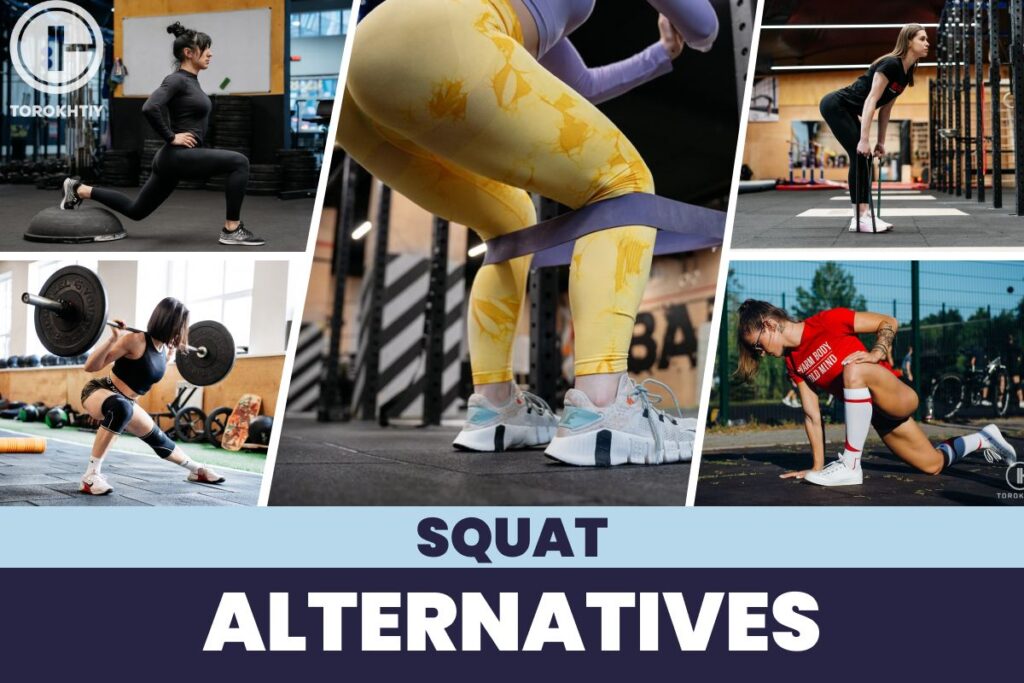
However, despite their significant benefits, squats are not always suitable for everyone. Factors such as injuries, joint pain or limited equipment can necessitate the need for alternatives.
Whether it’s due to a bad back, knee issues or simply not having access to squat racks, finding effective substitutes is crucial to maintain progress and stay healthy. Squat alternatives can provide similar benefits, helping to be strength and muscle, without aggravating existing conditions or constraints.
In this article, we will delve into an array of squat alternatives. These will include bodyweight exercises, unilateral movements, and other techniques that can replicate the muscle activation patterns of traditional squats.
We will examine, however, variations like lunges, step-ups and presses, can serve as alternatives to squats, offering variety, and specificity to tell her fitness to individual needs.
By the end of this article, you will have a comprehensive kit of exercises at your disposal, ensuring that your training continues effectively no matter the circumstance. Join us as we explore the landscape of squat alternatives, embracing the diversity and adaptability of strength training.
Understanding The Need Of Squat Alternatives
While squats are a fundamental component of strength training, they are not universally feasible for every fitness enthusiast. The need for substitutes arises from a multitude of personal health considerations and physical limitations.
Squatting, especially with weight, places significant stress on the back, hips, knees, which can exacerbate existing conditions or lead to discomfort. Thus, identifying substitutes for squats that align with individual capabilities is critical for a safe and sustainable exercise routine.
A bad back is one of the primary reasons individuals seek a squat alternative. The axial load or the force applied along the spine during the traditional squat, can be problematic for those with chronic back issues, such as herniated discs or general lower back pain.
A squat alternative for bad back would redistribute this load or eliminate it entirely, allowing individuals to train their lower body without risk and spinal health.
Similarly, those with hip problems, such as impingement, arthritis or postoperative restrictions, might find the depth and position of a conventional squat unmanageable. Squat alternatives for bad hip often include movements that limit the range of motion or provide a different angle of resistance to minimize hips while still engaging the same muscle groups.
Moreover, individuals with knee issues, including ligament injuries or post-surgical conditions might find the compressive force of squatting to be contraindicated. Squat alternatives for bad knees focus on reducing the sharing forces and pressure on joints emphasizing muscle engagement without joint compromise.
In summary, while traditional squats have their place as instrument training the reality of physical limitation cannot be overlooked. The good news is that a variety of alternatives exist, which can be tailored to the individual needs of those with back hip or knee concerns, allowing for effective lower body training.
These alternatives are not merely stop-gaps solutions, but valuable exercises in their own right, capable of building strength and muscle, improving balance and enhancing overall functional mobility.
Follow us!

Free!
Get a 2-week Weightlifting Program as a bonus for the subscription to kickstart your training plan!

Free!
10 Exercises To Replace Squats – General Alternatives
For those seeking exercise to replace squats due to constraints such as equipment, availability or personal comfort, numerous alternatives can be incorporated into a fitness routine.
These exercises aim to engage the major muscle groups as squats do – glutes, hamstrings and core, while using minimal or no equipment here are several effective substitutes:
1. Lunges
Lunges are not versatile, but also highly effective, engaging multiple lower body muscles, including the quadriceps, hamstrings and glutes similar to squats.
They can be performed in various directions:
- forward, which targets more glutes and hamstrings;
- backward, which places a little more emphasis on the quads;
- side lunges, which work on the inner and outer thighs.
Lunges can be done with just bodyweight, making them accessible for all fitness levels or with and handled weights like dumbbells or kettlebells for increased resistance and muscle building.
2. Step-ups
Step-ups replicate the one-legged squat, demanding balance and coordination while specifically targeting the quadriceps and glutes. Utilizing a bench or a step, this exercise helps improve unilateral strength and stability, which is crucial for balance in everyday activities.
The height of the step can be varied to adjust the difficulty level. Higher steps will increase the intensity, more closely stimulating a deep squat position. It’s also an excellent way to prepare the body for more complex movements.
3. Glute bridges
Glute bridges are performed by lying on your back with feet planted on the ground, and lifting the hips to create a bridge. This exercise isolates the posterior chain muscles, particularly the glutes and hamstrings, which are essential for the powerful squat.
By adding variations, such as single-leg bridges or using resistance bands around the thighs, the intensity can be increased, further engaging the core and hip muscles for a comprehensive posterior workout.
4. Wall Sits
Wall sits are a test of endurance for the quads and glutes. By maintaining a squat position against the wall, the muscles are kept under constant attention, which can significantly improve muscular endurance and strength overtime.
This exercise is also beneficial for those with back issues since the wall provides support, reducing the risk of strain.
5. Bulgarian Split Squats
Bulgarian split squats require a bench or any stable surface to elevate the rear foot, intensifying the focus on the lead leg`s quadriceps and glutes. This split stance allows to eliminate the load from the back, making it a safer alternative for those concerned with spinal health.
As with lunges, adding weight can significantly increase the difficulty and muscle engagement for further gains.
6. Box squats
Box squats are an excellent way to learn proper squat form as the box guides the athlete allowing for consistent depth with each repetition. They target the same muscle groups as traditional squats: quads, hamstrings and glutes, but reduce the risk of going too low and compromising form.
They also enable athletes to focus on the concentric phase of standing up from the seated position, which can help build explosive strength.
7. Resistance Band Leg Presses
Resistance band leg presses can be done on the ground with the bands providing variable resistance that can target the quadriceps, hamstrings and glutes. This alternative is particularly useful for those who may not have access to a press machine, but still wish to simulate similar muscle activation patterns.
8. Pistol Squats To A Bench
Progressing forward a full pistol squat, squatting down to a bench with one leg requires not only significant quad strength, but also considerable balance and stability. This exercise can help build the foundational strength needed for a full pistol squat, while being adjustable based on the bench height.
9. Weighted Goblet Squats
Goblet squats maintain the essence of the squat movement, but change the load to the front of the body, which can be more spine-friendly. The anterior weight forces the torso to stay more upright, working in the quadriceps while minimizing back strain. It’s a functional movement that mimics everyday activities like picking up groceries.
10. Single-Leg Romanian Deadlift
This exercise, focusing on hamstrings and glutes, but also requires a strong core to maintain stability, making it a comprehensive exercise that improves balance. The single-leg aspect ensures that each leg works independently, which can help correct muscle imbalances and increase unilateral strength.
Each of these exercises offers a way to target the muscles involved in squatting without needing a squat rack or even barbell. They can be adapted to suit various fitness levels and accommodate limitations, ensuring that the fundamental benefits of squatting – stronger and more balanced lower body and core are still attainable.
What to do instead of squats isn’t just about finding a direct substitute, but also involves incorporating a range of movements that replicate the multi-joint functionality of squats. This diversity not only prevents the risk of overuse injuries, but can also lead to more balanced muscular development and enhanced overall fitness.
7 Barbell Squat Alternatives
For those who can’t perform barbell squats, whether due to lack of equipment, personal preferences or injury concerns, there are numerous barbell squat alternatives that can’t effectively build leg strength and muscles.
These alternatives target the same primary muscles as the traditional squat: the quadriceps, hamstrings, glutes and even the core. Here are several effective exercises:
1. Leg Press Machine
The leg press is a staple alternative that allows you to load up weight similar to squat without the load on your back. It primarily works the quads, and to some degree hamstrings and glutes and allows for adjustments of food placement to target different muscle groups.
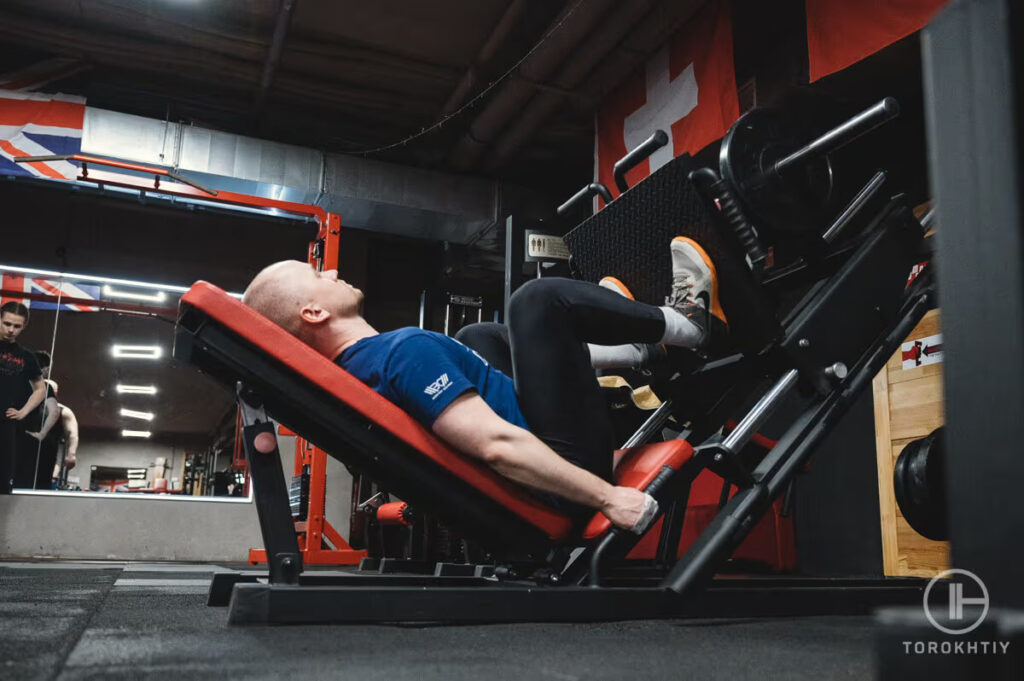
2. Hack Squat Machine
This machine offers a squat-like motion, while providing back support, which can be beneficial for individuals with back issues. It places a strong emphasis on the quads and allows for heavy lifting without the need to stabilize a barbell.
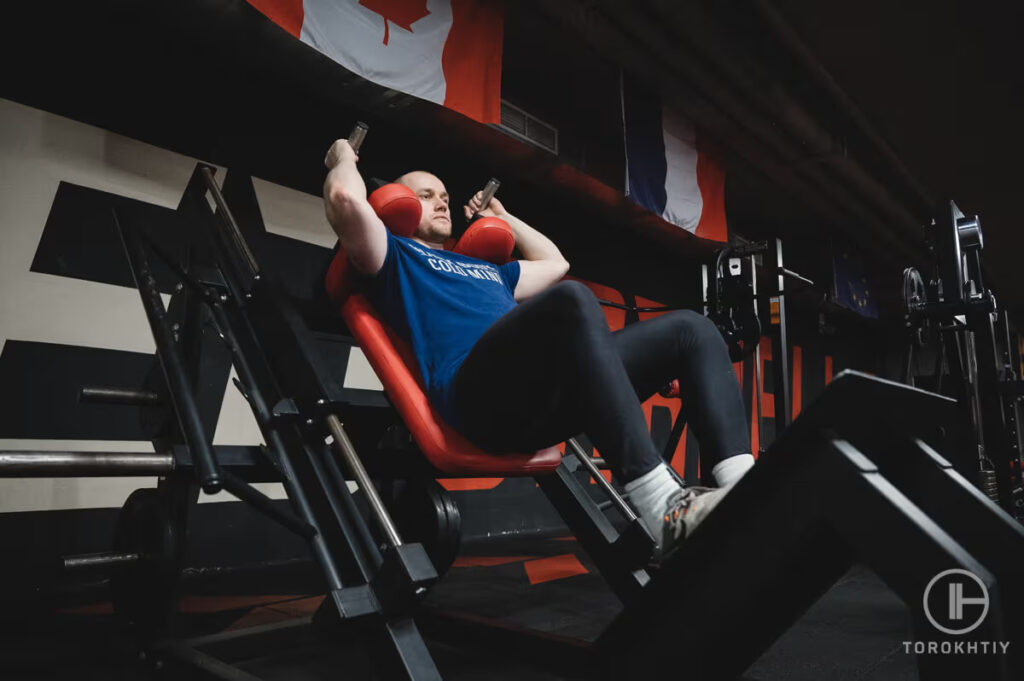
3. Belt Squats
By using a belt squat machine or a setup with a dip belt and weights, you can perform squats that entirely remove the wall from your spine. This focuses the effort on the leg and hips, providing a safe alternative for those with upper body injuries or limitations.
4. Smith Machine Squats
Although somewhat controversial due to the fixed path, Smith machine squats allow for squatting without needing to balance the bar, which can be helpful for beginners or those with balance issues.
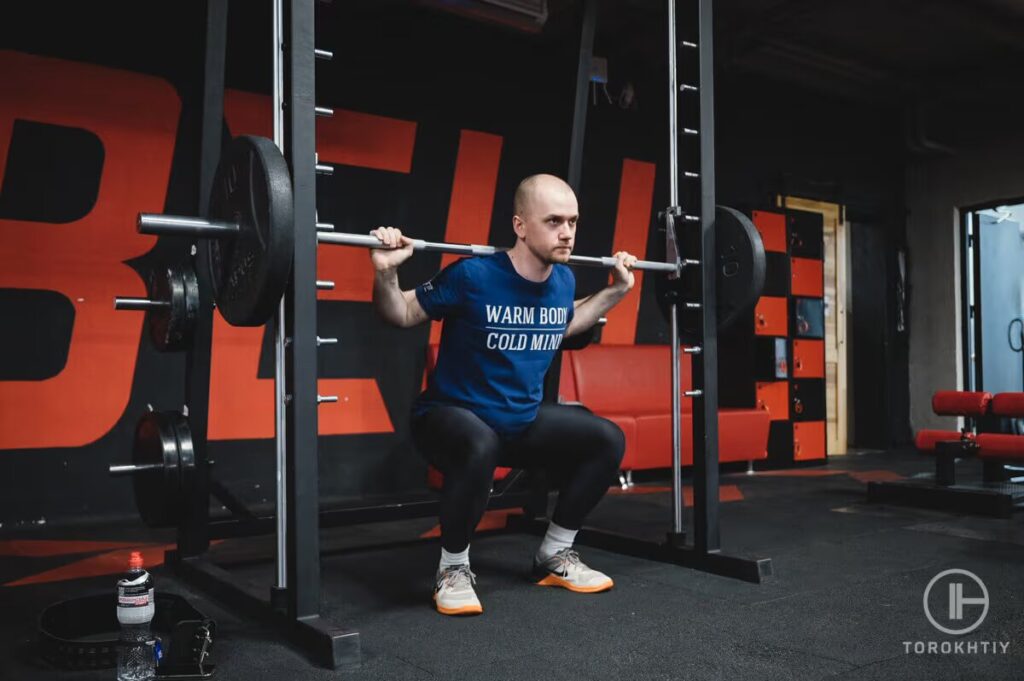
5. Resistance Band Squats
With bands under your feet and held at shoulder level, you can perform squats with accommodating resistance, which is easier to the joints while still providing a muscle build stimulus.
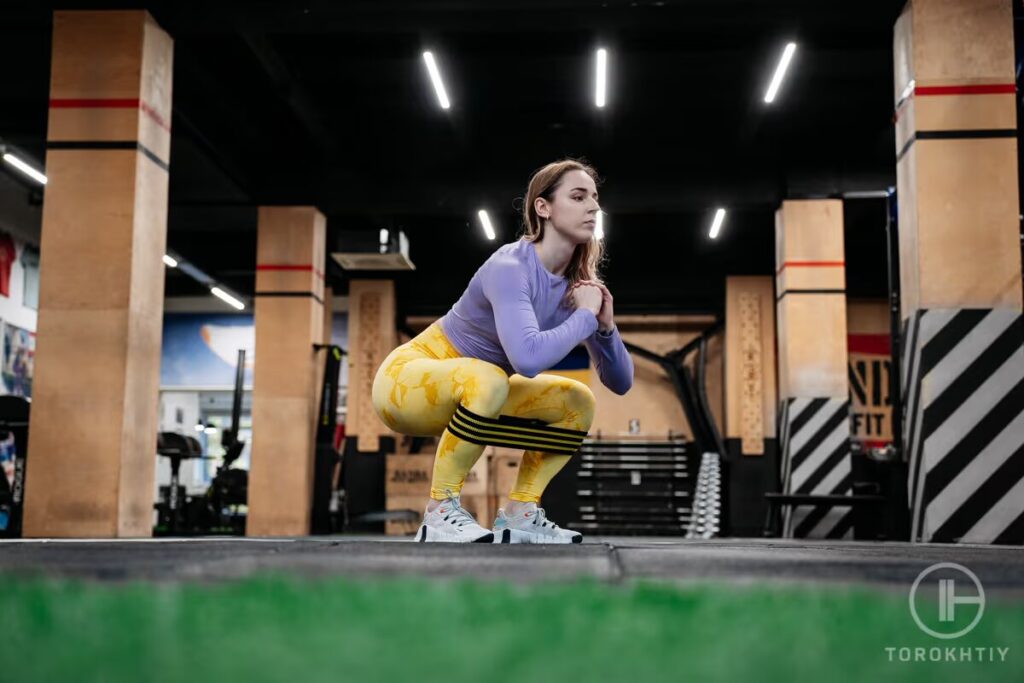
6. Cable Squats
By using a low pulley on a cable machine, you can perform squats with continuous tension throughout the movement, targeting the leg muscles effectively.
7. Medicine Ball Squats
A medicine ball placed against the wall and your lower back allows for squatting motion that reduces the stress on the back, yet still challenges the quads, hamstrings and glutes.
These barbell squat alternatives, not only accommodate various physical limitations and preferences, but also add diversity to like training which can help prevent plateaus. Incorporating different movements into your routine insurance comprehensive leg development and may improve overall muscle symmetry and function.
By understanding and utilizing these alternatives, you can continue to build leg strength and muscle effectively without the traditional barbell squat.
7 Squat Replacements for Specific Needs
For individuals facing challenges with traditional squats, due to back, hip or knee issues, finding suitable alternatives that allow for strength gains without exacerbating injuries is crucial.
Tailoring your workout to include back squat alternatives that focus on strengthening quads without squats is not just about maintaining fitness levels. It is also a proactive approach to rehabilitation and injury prevention. Here’s a guide to safely performing such alternatives:
1. Hip Thrusts
For individuals with back issues, hip thrusts provide a safe way to strengthen the glutes and hamstrings without putting axial load on the spine. Performed with the back on the bench and the barbell or weight across the hips, this exercise focuses on hip extension, crucial for lower body strength.
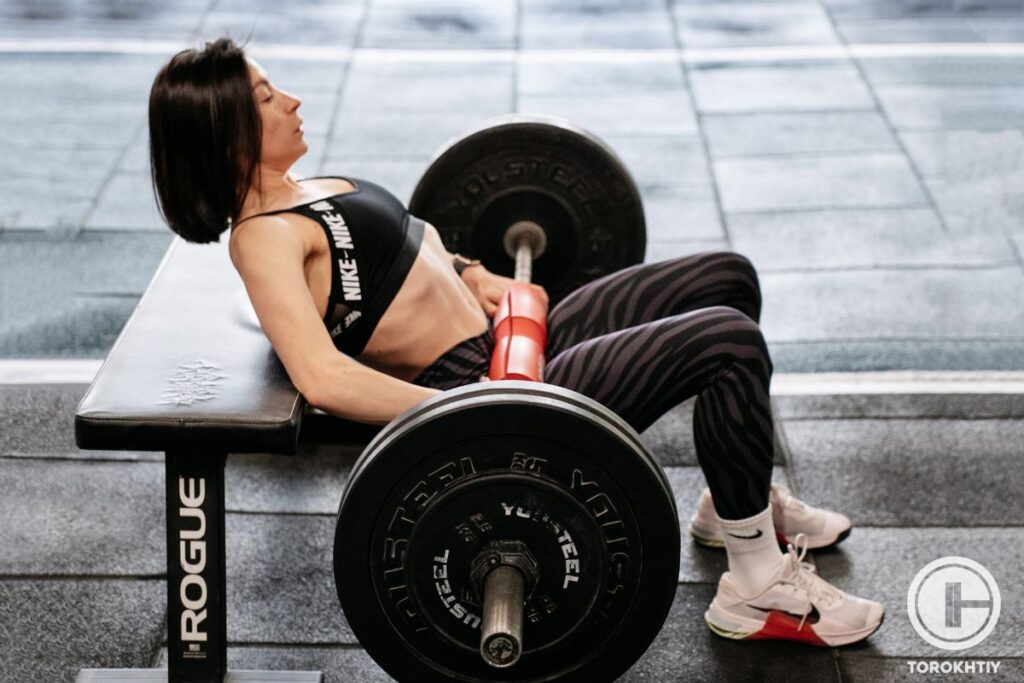
2. Aquatic Exercises
Water provides natural resistance, making specific aquatic exercises ideal for those with hip knee or back problems. Squat movements performed in water help strengthen the lower body while the water minimizes impact and supports the joints.
3. Stationary Bike
Cycling on a stationary bike, can strengthen the quads without squats and significant stress on back, hips or knees. It’s a low impact option that all allows for intensity adjustments to match individual fitness levels.
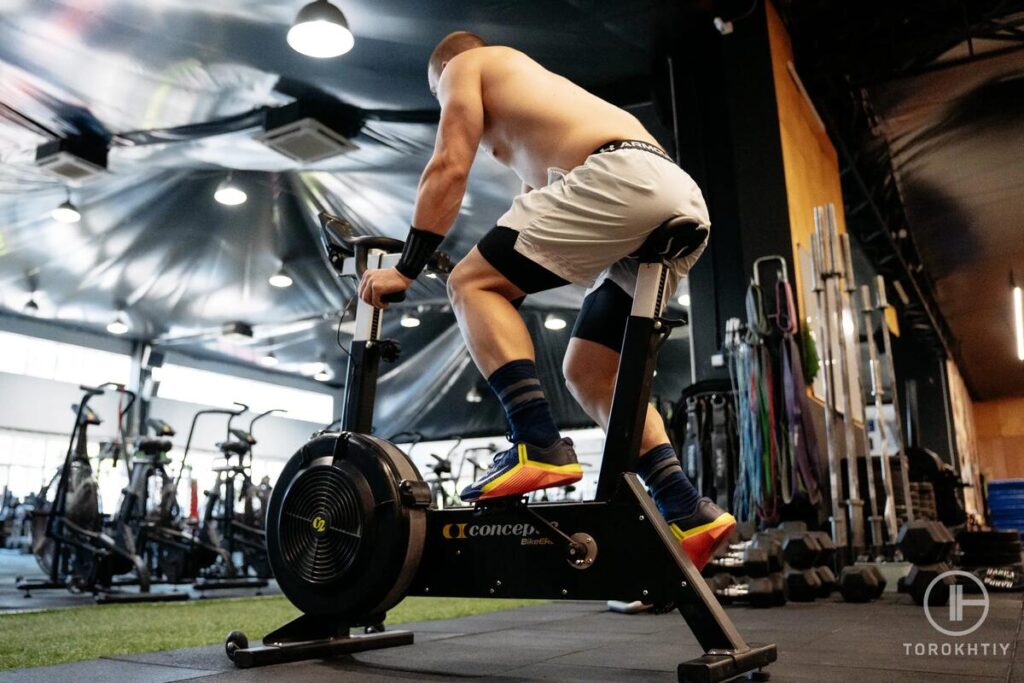
4. Leg Extensions
For targeting the quads, specifically like extensions can be effective. However, this exercise should be approached with caution, particularly for those with existing knee issues, and performed with light weights to avoid putting excessive strain on knee joints.
5. Cable Pull Throughs
This exercise is beneficial for individuals looking to minimize lower back strain, while working the posterior chain muscles, including the hamstrings and glutes. It involves pulling a cable between the legs from behind, which engages the glutes without heavy loading of the spine.
6. Nordic Hamstring Curls
This drill can be performed almost anywhere with minimal equipment and is excellent for strengthening the hamstrings, which support knee health. It involves a controlled descent and ascent with feet anchored and knees moving from flex to extend.
7. Seated Leg Curls
For targeting the hamstrings without placing stress on the back, seated leg curls are a viable option. This machine-based exercise allows for hamstring engagement in a controlled seated position, reducing the load on the spine.
Incorporating these alternatives into your training program, not only aids in strengthening the quads and other lower body muscles, but also ensures that individuals with specific needs can continue to progress without aggravating existing conditions.
Safety is paramount, so start with light resistance and focus on proper form. Gradually increasing the intensity, while listening to your body`s feedback is key to a successful adaptation. By employing these tailored alternatives, maintaining and even advancing lower body strength in the face of injuries or limitations becomes an achievable goal.
🔻GET A FREE PROGRAM DEMO: 12 Week Squat Program by Oleksiy Torokhtiy
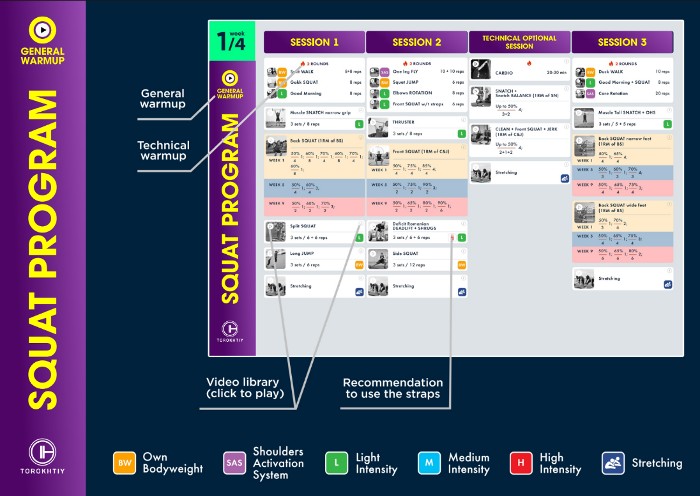
Do you want to double your squat strength? In just 12 weeks, you’ll be able to boost your squat results.
Enter your details and get a free demo (1 free week) of the squat program straight into your inbox.
Building Legs Without Squats
Building a strong, muscular, lower body without the traditional squat, requires a comprehensive approach that focuses on variation, intensity and volume in your leg workouts.
While squats are often considered the cornerstone of development, numerous effective strategies and exercises can serve as excellent squat replacements, allowing for balanced and robust leg growth.
1. Variation
Incorporating a wide range of exercises is key to targeting the legs from multiple angles and ensuring all muscle groups are engaged. Alternatives like lunges, step-ups, leg presses and hamstring curls can all contribute to well-rounded leg workout.
Variation not only helps in preventing boredom and plateauing, but also ensures that muscles are constantly being challenged in new ways, which is crucial for growth.
2. Intensity
To compensate for the absence of squats, which are inherently high-intensity due to their compound nature, it’s essential to focus on the intensity of your alternative exercises. This can be achieved through methods like progressive overload, where you gradually increase the weight or resistance overtime.
Additionally, incorporating advanced techniques such as drop sets, supersets or tempo changes can further enhance the intensity of your workouts, driving muscle growth and strength gains.
3. Volume
The volume of your workouts – how many exercises, sets and reps you perform is another critical factor in building muscles without squats. A higher volume can stimulate muscle hypertrophy, especially when employing a variety of exercises that target different aspects of leg muscles.
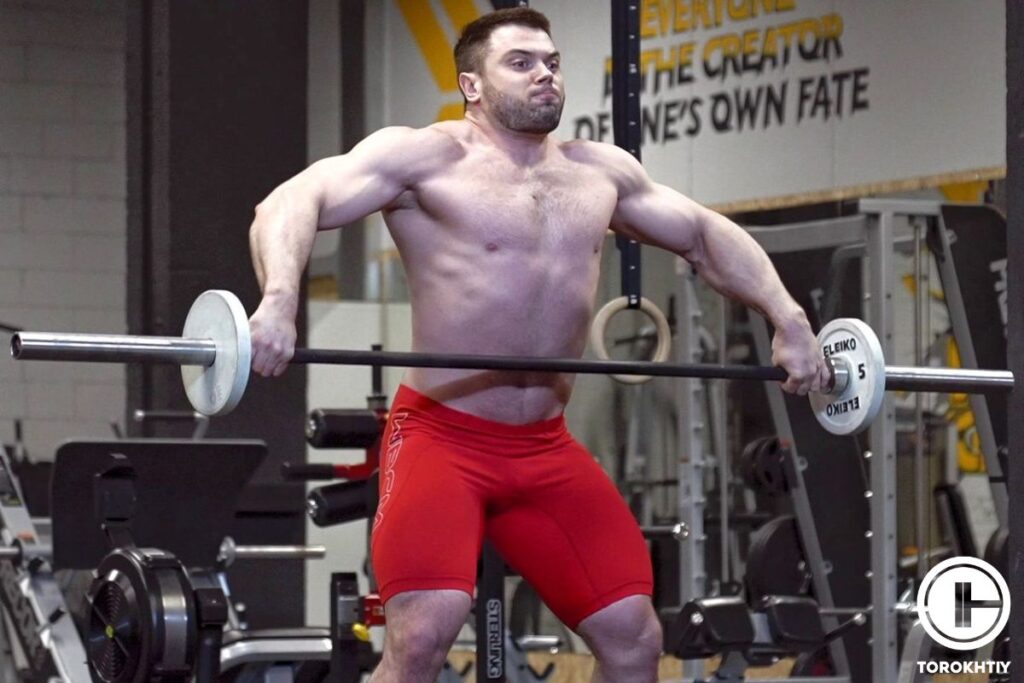
It’s important to find a balance that allows for sufficient stimulus, without leading to overtraining or injury. Adequate rest and recovery between sessions are just as crucial as the workout themselves.
4. Unilateral Exercises
Focusing on unilateral exercises, such as single leg deadlifts, and Bulgarian split squats, can also be beneficial. These movements not only ensure that both legs are working independently, minimizing imbalances, but also tend to require less overall load to achieve muscle fatigue, which can be advantages for those with limitations or injuries.
5. Nutrition and Recovery
Lastly, pay attention to nutrition and recovery is essential for muscle growth. Adequate protein, intake, hydration, and sufficient rest are foundational elements that support the body’s ability to recover and build muscle.
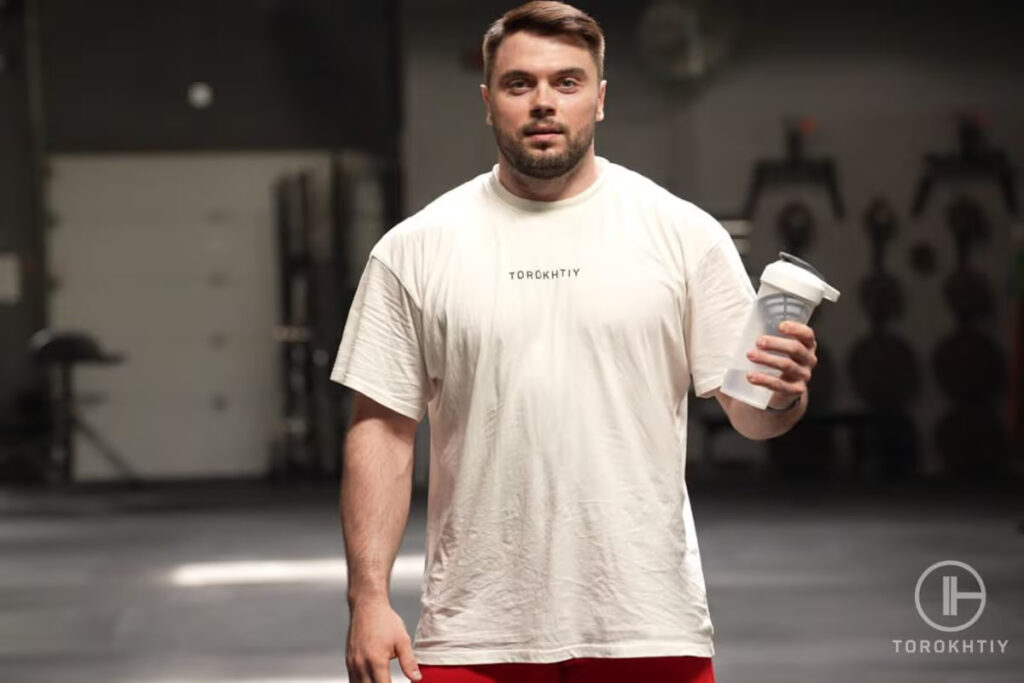
FAQ
Can I Build Legs Without Squats?
Yes, you can build strong legs without squats by utilizing exercises like lunges, step-ups, glute bridges and Bulgarian split squats. These provide comprehensive leg development, targeting multiple muscle groups and can be adjusted for intensity and volume to stimulate growth.
Can Leg Press Replace Squats?
While leg presses work similar muscles, they don’t fully replace squats as they lack the stabilization and coordination component. However, leg presses are effective for building leg strength and muscle in a more fixed pattern of movement.
Conclusion
Building legs without squats is entirely possible by employing a diverse range of exercises, focusing on workout intensity, and carefully managing workout volume. By adopting these principles, you can develop strong, muscular legs that are balanced and functional, even without the traditional squat.
By focusing on exercises that cater to specific needs and emphasize variation, intensity and volume individuals can effectively build leg strength and muscle. These alternatives provide safe options and add valuable variety to fitness routines.
We encourage you to share your experiences with these alternatives in the comments and spread the word by sharing this article. Your insights could greatly benefit others looking to enhance their workouts.
Also Read:
- 14 Best Back Squat Alternatives Trainers Recommend
- 10 Best Squat Alternatives For Bad Back (CPT Recommended)
- 10 Best Front Squat Alternatives for Home and Gym
- 5 Best Squat Alternatives For Bad Knees
- Do Squats Work Abs? Variations & 5 Alternatives
References:
- Mackey ER, Riemann BL. Biomechanical Differences Between the Bulgarian Split-Squat and Back Squat. Int J Exerc Sci. 2021 Apr 1;14(1):533-543. PMID: 34055144; PMCID: PMC8136570.
- Wei W, Zhu J, Ren S, Jan YK, Zhang W, Su R, He L. Effects of progressive body-weight versus barbell back squat training on strength, hypertrophy and body fat among sedentary young women. Sci Rep. 2023 Aug 19;13(1):13505. doi: 10.1038/s41598-023-40319-x. PMID: 37598268; PMCID: PMC10439966.
- Brazil A, Needham L, Palmer JL, Bezodis IN. A comprehensive biomechanical analysis of the barbell hip thrust. PLoS One. 2021 Mar 29;16(3):e0249307. doi: 10.1371/journal.pone.0249307. PMID: 33780488; PMCID: PMC8006986.
- Šarabon N, Marušič J, Marković G, Kozinc Ž. Kinematic and electromyographic analysis of variations in Nordic hamstring exercise. PLoS One. 2019 Oct 23;14(10):e0223437. doi: 10.1371/journal.pone.0223437. PMID: 31644582; PMCID: PMC6808554.
- Schwanbeck, Shane; Chilibeck, Philip D; Binsted, Gordon. A Comparison of Free Weight Squat to Smith Machine Squat Using Electromyography. Journal of Strength and Conditioning Research 23(9):p 2588-2591, December 2009. | DOI: 10.1519/JSC.0b013e3181b1b181
- Photos made by Torokhtiy Media Team.
Why Trust Us?
With over 20 years in Olympic weightlifting, strength training, nutrition coaching, and general fitness our team does its best to provide the audience with ultimate support and meet the needs and requirements of advanced athletes and professional lifters, as well as people who strive to open new opportunities and develop their physical capabilities with us.
By trusting the recommendations of our certified experts in coaching, nutrition, and sports training programming, as well as scientific consultants, and physiotherapists, we provide you with thorough, well-considered, and scientifically proven content. All the information given in the articles concerning workout programming, separate exercises, and athletic performance, in general, is based on verified data.
The product testing process is described in more detail here.
Author: Sergii Putsov
Head of Sport Science, PhD
Best Results: Snatch – 165 kg,
C&J – 200 kg
Sergii Putsov, Ph.D., is a former professional weightlifter and National team member, achieving multiple medals in the 94 kg weight category at national competitions. With a Master’s degree in “Olympic & Professional Sport Training” and a Sport Science Ph.D. from the International Olympic Academy, Greece, Sergii now leads as the Head of Sport Science. He specializes in designing training programs, writing insightful blog articles, providing live commentary at international weightlifting events, and conducting educational seminars worldwide alongside Olympic weightlifting expert Oleksiy Torokhtiy.
Reviewed by: Oleksiy Torokhtiy
Olympic Weightlifting Champion, PhD in Sport Science
Best Results: Snatch – 200 kg,
C&J – 240 kg
Oleksiy Torokhtiy is a professional athlete boasting 20 years of experience in Olympic weightlifting. With multiple European and World titles under his belt, he has showcased his prowess in two Olympic Games (Beijing 2008 and London 2012). Upon concluding his illustrious career, Oleksiy dedicated himself to coaching. By 2022, he had conducted over 200 weightlifting seminars worldwide. He is the visionary behind an international sportswear and accessories brand known for its motto, “Warm Body Cold Mind.” Additionally, he is an esteemed author and the creator of a series of training programs and eBooks.




Still have questions after reading our article? Unlock your full potential by engaging with our experts and community! Don’t hesitate — leave a comment below and Sergii Putsov will provide a personalized answer and insights to help you reach your goals.